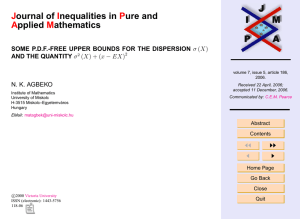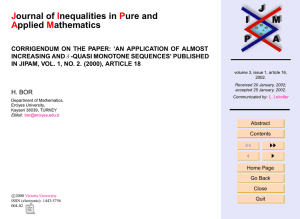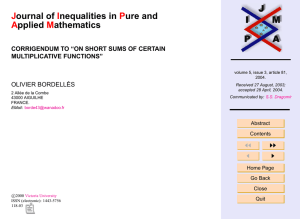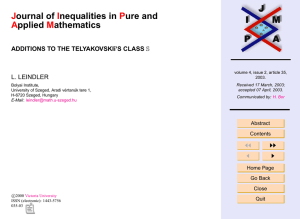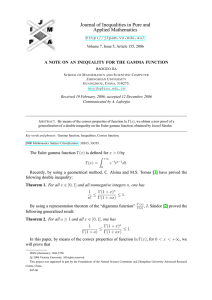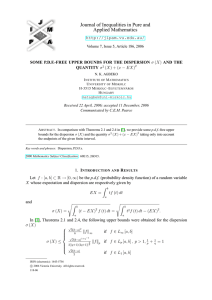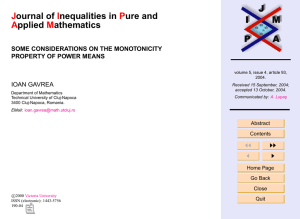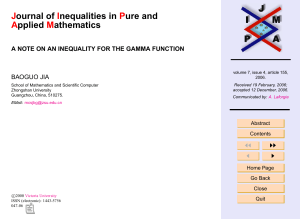Document 10709087
advertisement
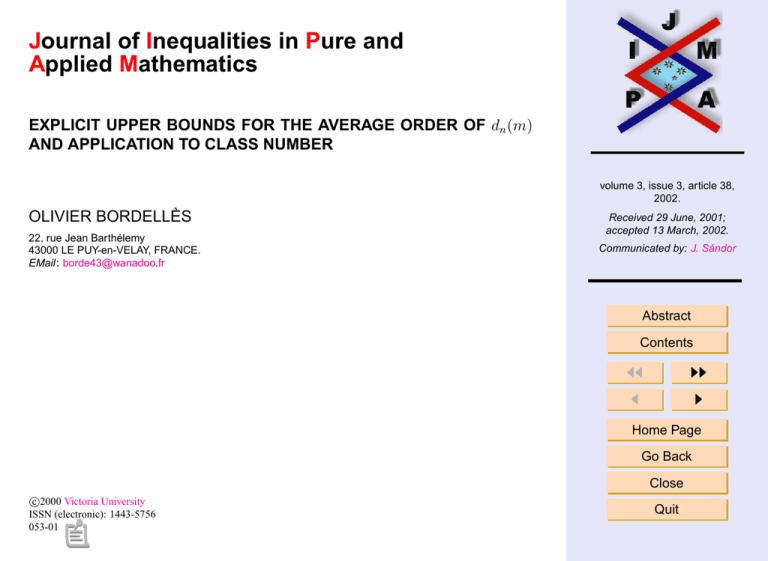
Journal of Inequalities in Pure and
Applied Mathematics
EXPLICIT UPPER BOUNDS FOR THE AVERAGE ORDER OF dn (m)
AND APPLICATION TO CLASS NUMBER
volume 3, issue 3, article 38,
2002.
OLIVIER BORDELLÈS
22, rue Jean Barthélemy
43000 LE PUY-en-VELAY, FRANCE.
EMail: borde43@wanadoo.fr
Received 29 June, 2001;
accepted 13 March, 2002.
Communicated by: J. Sándor
Abstract
Contents
JJ
J
II
I
Home Page
Go Back
Close
c
2000
Victoria University
ISSN (electronic): 1443-5756
053-01
Quit
Abstract
In this paper, we prove some explicit upper bounds for the average order of the
generalized divisor function, and, according to an idea of Lenstra, we use them
to obtain bounds for the class number of number fields.
2000 Mathematics Subject Classification: 11N99, 11R29.
Key words: Multiplicative number theory, Average order, Class number.
Explicit Upper Bounds for the
Average Order of dn (m) and
Application to Class Number
We would like to thank Professor Joszef Sándor for his helpful comments. We also
are indebted to Professor Patrick Sargos for the proof of the Erdös-Turán inequality
in the form used here.
Olivier Bordellès
Contents
1
Introduction . . . . . . . . . . . . . . . . . . . . . . . . . . . . . . . . . . . . . . . . .
2
Notation . . . . . . . . . . . . . . . . . . . . . . . . . . . . . . . . . . . . . . . . . . . .
3
Basic Properties of the Generalized Divisor Function . . . . . . .
4
Results . . . . . . . . . . . . . . . . . . . . . . . . . . . . . . . . . . . . . . . . . . . . .
5
Application to Class Number . . . . . . . . . . . . . . . . . . . . . . . . . . .
6
Proofs of the Theorems . . . . . . . . . . . . . . . . . . . . . . . . . . . . . . . .
7
Using the Convolution Relation in a Different Way . . . . . . . .
8
Case of Quadratic Fields . . . . . . . . . . . . . . . . . . . . . . . . . . . . . .
A
Appendix . . . . . . . . . . . . . . . . . . . . . . . . . . . . . . . . . . . . . . . . . . .
References
Title Page
3
6
8
10
11
12
16
20
30
Contents
JJ
J
II
I
Go Back
Close
Quit
Page 2 of 35
J. Ineq. Pure and Appl. Math. 3(3) Art. 38, 2002
http://jipam.vu.edu.au
1.
Introduction
Let K be a number field of degree n, signature (r1 , r2 ) , discriminant d (K) ,
r
1
Minkowski bound b (K) := b = nn!n π4 2 |d (K)| 2 and class number h (K) .
We denote by OK the ring of algebraic integers of K. We are interested here in
finding explicit upper bounds for h (K) of the type
1
h (K) ≤ ε (n) |d (K)| 2 (log |d (K)|)n−1 ,
where ε (n) is a positive constant depending on n, and log is the natural logarithm.
There are several methods to get such bounds for h (K) : Roland Quême in
[8] used the geometry of numbers to prove that if b > 17,
r 2
1
2
R (K) h (K) ≤ w (K)
|d (K)| 2 (2 log b)n ,
π
Explicit Upper Bounds for the
Average Order of dn (m) and
Application to Class Number
Olivier Bordellès
Title Page
Contents
where R (K) is the regulator of K, and w (K) is the number of roots of unity in
K.
In [5], Stéphane Louboutin proved, by using analytic methods, that
w (K)
R (K) h (K) ≤
2
r 2
n−1
1
2
e
log
|d
(K)|
|d (K)| 2
,
π
4 (n − 1)
and, if K is a totally real abelian extension of Q,
R (K) h (K) ≤ d (K)
1
2
n−1
log d (K)
+ 0.025
.
4 (n − 1)
JJ
J
II
I
Go Back
Close
Quit
Page 3 of 35
J. Ineq. Pure and Appl. Math. 3(3) Art. 38, 2002
http://jipam.vu.edu.au
The methods used to get these bounds are very deep, but it is necessary to
compute the regulator (which is usually not easy), or use the Zimmert’s lower
bound for R (K) (see [11]):
R (K) ≥ 0.02 w (K) e0.46r1 +0.1r2 .
We want to prove some inequalities involving h (K) in an elementary way:
we have
h (K) ≤ |{a : integral ideal of OK , N (a) ≤ b}| ,
where N (a) denotes the absolute norm of a, and, using an idea of H.W. Lenstra
(see [4]), we can see, by considering how prime numbers can split in K, that,
for each positive integer m, the number of integral ideals a of absolute norm m
is bounded by the number of solutions of the equation
a1 a2 · · · an = m
(ai ∈ N∗ ) .
Lenstra deduced that
(1.1)
h (K) ≤ |{(a1 , . . . , an ) ∈ (N∗ )n , a1 a2 · · · an ≤ b}| .
Now the idea is to work with the generalized divisor function dn , since (1.1)
is equivalent to:
Explicit Upper Bounds for the
Average Order of dn (m) and
Application to Class Number
Olivier Bordellès
Title Page
Contents
JJ
J
II
I
Go Back
Close
Quit
Lemma 1.1. Let K be a number field of degree n ≥ 2, and b be the Minkowski
bound of K. Then:
X
h (K) ≤
dn (m) .
Page 4 of 35
m≤b
J. Ineq. Pure and Appl. Math. 3(3) Art. 38, 2002
http://jipam.vu.edu.au
In an oral communication, J.L. Nicolas and G. Tenenbaum proved that, for
any integer n ≥ 1 and any real number x ≥ 1,
X
x
(1.2)
dn (m) ≤
(log x + n − 1)n−1 .
(n − 1)!
m≤x
(one can prove this inequality by induction).
Hence, by Lemma 1.1 and (1.2), we get Lenstra’s result, namely:
h (K) ≤
b
(log b + n − 1)n−1 .
(n − 1)!
Explicit Upper Bounds for the
Average Order of dn (m) and
Application to Class Number
Olivier Bordellès
Title Page
Contents
JJ
J
II
I
Go Back
Close
Quit
Page 5 of 35
J. Ineq. Pure and Appl. Math. 3(3) Art. 38, 2002
http://jipam.vu.edu.au
2.
Notation
We mention here some notation that will be used throughout the paper:
General. m, n, r, s will always denote positive integers, x a real number ≥ 1,
and [x] denote the integral part of x, the unique integer satisfying x − 1 < [x] ≤
x.
• ψ (x) := x − [x] − 12 , and e (x) := e2iπx . ψ is 1-periodic and |ψ (x)| ≤ 12 .
• γ ≈ 0.5772156649015328606065120900... is the Euler constant.
• For any finite set E, |E| denotes the number of elements in E.
On number fields. K is a number field of degree n ≥ 2, signature (r1 , r2 ) ,
r
1
discriminant d (K) , Minkowski bound b = nn!n π4 2 |d (K)| 2 , class number
h (K).
On arithmetical functions. By 1, we mean the arithmetical function defined by
1 (m) = 1 for any positive integer m.
The generalized divisor function dn is defined by
X
d1 (m) = 1, dn (m) :=
1 (n ≥ 2) ,
a1 a2 ···an =m
and, if n = 2, we simply denote it by d (m) .
Explicit Upper Bounds for the
Average Order of dn (m) and
Application to Class Number
Olivier Bordellès
Title Page
Contents
JJ
J
II
I
Go Back
Close
Quit
Page 6 of 35
J. Ineq. Pure and Appl. Math. 3(3) Art. 38, 2002
http://jipam.vu.edu.au
If f and g are two arithmetical functions, the Dirichlet convolution product
of f and g is defined by
m
X
(f ∗ g) (m) :=
f (δ) g
.
δ
δ|m
Explicit Upper Bounds for the
Average Order of dn (m) and
Application to Class Number
Olivier Bordellès
Title Page
Contents
JJ
J
II
I
Go Back
Close
Quit
Page 7 of 35
J. Ineq. Pure and Appl. Math. 3(3) Art. 38, 2002
http://jipam.vu.edu.au
3.
Basic Properties of the Generalized Divisor Function
The properties of the generalized divisor function can be found in [5], [9] and
[10]. For our purpose, we only need to know that dn is multiplicative (i.e.
dn (rs) = dn (r) dn (s) whenever gcd (r, s) = 1) and, for any prime number p
and any non-negative integer l, we have :
n+l−1
l
dn p =
,
l
where ab denotes a binomial coefficient ([9], equality (4)).
It’s important to note that we have
(3.1)
dn = 1
∗ ... ∗ 1}
| ∗ 1 {z
(n ≥ 1) .
Explicit Upper Bounds for the
Average Order of dn (m) and
Application to Class Number
Olivier Bordellès
Title Page
n times
Contents
n−1
One knows that the average order of dn (m) is ∼ (log m)
/ (n − 1)! : to
see this, one can use the following result ([9], equality (18)):
X
1
1
n−1
+O
(x > 1, n ≥ 2) .
dn (m) = x (log x)
(n
−
1)!
log
x
m≤x
JJ
J
II
I
Go Back
Close
Our aim is to compute several constants κ (n) depending (or not) on n such that
X
dn (m) ≤ κ (n) x (log x)n−1 .
Quit
Page 8 of 35
m≤x
We will need the following lemma:
J. Ineq. Pure and Appl. Math. 3(3) Art. 38, 2002
http://jipam.vu.edu.au
Lemma 3.1. Let x ≥ 1. Then:
X 1
ψ (x)
ε
= log x + γ −
+ 2
m
x
x
m≤x
with
1
|ε| ≤ .
4
This result is well-known, and a proof can be found in [2].
Explicit Upper Bounds for the
Average Order of dn (m) and
Application to Class Number
Olivier Bordellès
Title Page
Contents
JJ
J
II
I
Go Back
Close
Quit
Page 9 of 35
J. Ineq. Pure and Appl. Math. 3(3) Art. 38, 2002
http://jipam.vu.edu.au
4.
Results
Theorem 4.1. Let n ≥ 1 be an integer and x ≥ 1 a real number. Then:
n−1
X
1
dn (m) ≤ x log x + γ +
.
x
m≤x
Theorem 4.2. Let n ≥ 1 be an integer and x ≥ 6 a real number. Then:
X
dn (m) ≤ 2x (log x)n−1 .
m≤x
Explicit Upper Bounds for the
Average Order of dn (m) and
Application to Class Number
Olivier Bordellès
Title Page
Contents
JJ
J
II
I
Go Back
Close
Quit
Page 10 of 35
J. Ineq. Pure and Appl. Math. 3(3) Art. 38, 2002
http://jipam.vu.edu.au
5.
Application to Class Number
Theorem 5.1. Let K be a number field of degree n, Minkowski bound b and
class number h (K) . Then:
h (K) ≤ b log b + γ + b−1
n−1
.
Theorem 5.2. Let K be a number field of degree n ≥ 2, Minkowski bound b
and class number h (K) . Then, if b ≥ 6,
n−1
h (K) ≤ 2b (log b)
.
Theorem 5.3. Let K be a number field of degree n, discriminant d (K) and
class number h (K) . Then :
1
2n−1
h (K) ≤
|d (K)| 2 (log |d (K)|)n−1 .
(n − 1)!
More generally, if a > 0 is satisfying a ≥ 2 (n − 1) / (log |d (K)|) , then
h (K) ≤
a+1
2
n−1
Explicit Upper Bounds for the
Average Order of dn (m) and
Application to Class Number
Olivier Bordellès
Title Page
Contents
JJ
J
II
I
1
|d (K)| 2
(log |d (K)|)n−1 .
(n − 1)!
Go Back
Close
Quit
Page 11 of 35
J. Ineq. Pure and Appl. Math. 3(3) Art. 38, 2002
http://jipam.vu.edu.au
6.
Proofs of the Theorems
In the following proofs, we set
Sn (x) :=
X
dn (m) .
m≤x
Proof of Theorem 4.1.
X
Sn (x) =
X
1=
m≤x a1 ....an =m
≤
X
a1 ≤x
...
XX
a1 ≤x a2 ≤x
...
X
an ≤x/(a1 ...an−1 )
X1
x
=x
a ...an−1
a
a≤x
≤x 1
!n−1
X
an−1
1
,
Explicit Upper Bounds for the
Average Order of dn (m) and
Application to Class Number
Olivier Bordellès
and we use Lemma 3.1 to conclude the proof.
Title Page
Proof of Theorem 4.2.
Contents
1. We first note that, since
1,
if 1 ≤ t < 2,
n + 1,
if 2 ≤ t < 3,
2n + 1,
if 3 ≤ t < 4,
(n2 +5n+2)
, if 4 ≤ t < 5,
2
Sn (t) =
(n2 +7n+2)
, if 5 ≤ t < 6,
2
(3n2 +7n+2)
, if 6 ≤ t < 7,
2
(3n2 +9n+2)
, if 7 ≤ t < 8,
2
JJ
J
II
I
Go Back
Close
Quit
Page 12 of 35
J. Ineq. Pure and Appl. Math. 3(3) Art. 38, 2002
http://jipam.vu.edu.au
then
Z e2
−2
t Sn (t) dt =
1
7
3e−2
−
24
2
2
n +
1093 9e−2
−
840
2
n + 1 − e−2 ,
and then, if n ≥ 2,
Z
(6.1)
1
e2
2n2
.
t Sn (t) dt <
3
−2
2. Let x ≥ 6, n ≥ 1. The theorem is true if n = 1, since S1 (x) = [x] ≤ x,
so we prove the result for n ≥ 2.
We first check that the theorem is true when 6 ≤ x < e2 . Indeed, in this
case, we have
2x (log x)n−1 ≥ 12 (log 6)n−1 > 4n2 ≥
Explicit Upper Bounds for the
Average Order of dn (m) and
Application to Class Number
Olivier Bordellès
Title Page
2
3n + 9n + 2
= Sn e2 ≥ Sn (x) .
2
so we can suppose that x ≥ e2 and n ≥ 2.
We prove the inequality by induction : if n = 2,
X X
S2 (x) =
1 ≤ x log x + x ≤ 2x log x.
Contents
JJ
J
II
I
Go Back
Close
r≤x s≤x/r
Quit
Assume it is true for some n ≥ 2. By (3.1), we have:
X
Sn+1 (x) =
(dn ∗ 1) (m)
m≤x
Page 13 of 35
J. Ineq. Pure and Appl. Math. 3(3) Art. 38, 2002
http://jipam.vu.edu.au
=
XX
dn (δ)
m≤x δ|m
=
X
dn (δ)
hxi
δ≤x
≤x
δ
X dn (δ)
δ≤x
x
δ
Z
t−1 d (Sn (t))
1−
Z x
= Sn (x) + x
t−2 Sn (t) dt
=x
Explicit Upper Bounds for the
Average Order of dn (m) and
Application to Class Number
Olivier Bordellès
1
Z
e2
= Sn (x) + x
t−2 Sn (t) dt + x
Z
x
t−2 Sn (t) dt.
Title Page
e2
1
Contents
Using (6.1) and induction hypothesis, we get
Z x
2n2 x
Sn+1 (x) ≤ 2x (log x)
+
+ 2x
t−1 (log t)n−1 dt
3
2
e
2x
2n2 2n+1
n
n−1
=
(log x) + x 2 (log x)
+
−
n
3
n
n
= 2x (log x) − xfn (x) ,
n−1
JJ
J
II
I
Go Back
Close
Quit
where
Page 14 of 35
fn (x) :=
2−
2
n
(log x)n − 2 (log x)n−1 +
2
n+1
2n
2
−
3
n
.
J. Ineq. Pure and Appl. Math. 3(3) Art. 38, 2002
http://jipam.vu.edu.au
Now we have
2n2
≥ 0,
fn (x) ≥ fn e2 = 2n −
3
hence
Sn+1 (x) ≤ 2x (log x)n .
This concludes the proof of Theorem 4.2.
Proof of Theorems 5.1 & 5.2. Direct applications of Theorems 4.1 and 4.2.
Proof of Theorem 5.3. Let a > 0, and suppose x ≥ e(n−1)/a . Then n − 1 ≤
a log x, and, using (1.2),
Explicit Upper Bounds for the
Average Order of dn (m) and
Application to Class Number
(a + 1)n−1
Sn (x) ≤
x (log x)n−1 .
(n − 1)!
Olivier Bordellès
(6.2)
1
2
Now, Since b < |d (K)| , we have, by Lemma 1.1,
X
h (K) ≤
dn (m) .
m≤|d(K)|1/2
We then use the inequality ([6], Lemma 10)
|d (K)| ≥ e2(n−1)/3
Title Page
Contents
JJ
J
II
I
Go Back
Close
Quit
and (6.2) with a = 3 to get the first part of Theorem 5.3.
The 2nd part comes directly from (6.2). This concludes the proof of Theorem
5.3.
Page 15 of 35
J. Ineq. Pure and Appl. Math. 3(3) Art. 38, 2002
http://jipam.vu.edu.au
7.
Using the Convolution Relation in a Different
Way
We now want to prove another bound, using the Dirichlet hyperbola principle:
Theorem 7.1. Let K be a number field of degree n, Minkowski bound b and
class number h (K) . Then, if b ≥ 36,
(i) n = 2p (p ≥ 1) ,
h (K) ≤
2p−2
b
(log b)p (log b + p − 1)p−1 ,
(p − 1)!
Explicit Upper Bounds for the
Average Order of dn (m) and
Application to Class Number
Olivier Bordellès
(ii) n = 2p + 1 (p ≥ 1) ,
Title Page
2
b
p
p−1
p
h (K) ≤ p
(log b) log b (log b + p − 1)
+
(log b + p) .
2 (p − 1)!
p
We first need the following result:
Lemma 7.2. Let x ≥ 6 be a real number and k ≥ 1 an integer. Then:
X dk (m)
≤ 2 (log x)k .
m
m≤x
Proof. The result is true if k = 1, so we suppose k ≥ 2. Suppose first that
Contents
JJ
J
II
I
Go Back
Close
Quit
Page 16 of 35
J. Ineq. Pure and Appl. Math. 3(3) Art. 38, 2002
http://jipam.vu.edu.au
x ≥ e2 . By partial summation, we can write, using Theorem 4.2,
Z x
X dk (m)
−1
= x Sk (x) +
t−2 Sk (t) dt
m
1
m≤x
Z e2
Z x
k−1
−2
≤ 2 (log x)
+
t Sk (t) dt + 2
t−1 (log t)k−1 dt
e2
k+1
1
2
<
2
2k
2
(log x)k + 2 (log x)k−1 +
−
,
k
3
k
and one can check that
k−1
2 (log x)
2k 2 2k+1
+
−
≤
3
k
3 1
−
2 k
(log x)k
if x ≥ e2 and k ≥ 2, hence
X dk (m) 3 1 ≤
+
(log x)k ≤ 2 (log x)k .
m
2
k
m≤x
Now, if 6 ≤ x < e2 and k ≥ 2, we get
2 (log x)k ≥ 2 (log 6)k
6k 2
>
5
1
>
245k 2 + 1093k + 840
840
Explicit Upper Bounds for the
Average Order of dn (m) and
Application to Class Number
Olivier Bordellès
Title Page
Contents
JJ
J
II
I
Go Back
Close
Quit
Page 17 of 35
J. Ineq. Pure and Appl. Math. 3(3) Art. 38, 2002
http://jipam.vu.edu.au
=
X dk (m)
m
2
m≤e
≥
X dk (m)
,
m
m≤x
which concludes the proof of Lemma 7.2.
Proof of Theorem 7.1. Let x ≥ 36 be a real number. If n = 2p is even, using
(3.1) again, we can write:
X
X
X
dn (m) =
dn/2 ∗ dn/2 (m) =
(dp ∗ dp ) (m) ,
m≤x
m≤x
m≤x
and, by the Dirichlet hyperbola principle, we get, for any real number T satisfying 1 ≤ T ≤ x,
X
X
X
X
X
dn (m) ≤
dp (m)
dp (r) +
dp (m)
dp (r) ,
m≤x
m≤T
r≤x/m
m≤x/T
r≤x/m
and then, using (1.2),
Explicit Upper Bounds for the
Average Order of dn (m) and
Application to Class Number
Olivier Bordellès
Title Page
Contents
JJ
J
II
I
Go Back
X
m≤x
dn (m) ≤
x
(p − 1)!
(
p−1
X dp (m) x
log + p − 1
m
m
m≤T
X dp (m)
p−1
x
+
log + p − 1
,
m
m
m≤x/T
Close
Quit
Page 18 of 35
J. Ineq. Pure and Appl. Math. 3(3) Art. 38, 2002
http://jipam.vu.edu.au
and, with Lemma 7.2, if min T, Tx ≥ 6, we get
X
m≤x
dn (m) ≤
x p o
2x (log x + p − 1)p−1 n
(log T )p + log
,
(p − 1)!
T
1
1
and we choose T = x 2 (so min T, Tx = x 2 ≥ 6) to conclude the proof.
If n = 2p + 1 is odd, then we write:
X
X
X
dn (m) =
d(n−1)/2 ∗ d(n+1)/2 (m) =
(dp ∗ dp+1 ) (m) .
m≤x
m≤x
m≤x
Explicit Upper Bounds for the
Average Order of dn (m) and
Application to Class Number
Olivier Bordellès
Title Page
Contents
JJ
J
II
I
Go Back
Close
Quit
Page 19 of 35
J. Ineq. Pure and Appl. Math. 3(3) Art. 38, 2002
http://jipam.vu.edu.au
8.
Case of Quadratic Fields
√ We suppose in this section that K = Q
d , where d ∈ Z\{0, 1} is supposed
to be squarefree. We denote here ∆ the discriminant and h (d) the class number.
We recall that:
d, if d ≡ 1 (mod 4) ,
∆=
4d, if d ≡ 2 or 3 (mod 4) .
The problem of the class number is in this case utterly resolved: for example,
if d < −4, we have (see [1], Corollary 5.3.13)
−1 X d
d
h (d) = 2 −
,
2
k
Explicit Upper Bounds for the
Average Order of dn (m) and
Application to Class Number
Olivier Bordellès
16k<|d|/2
d
where k represents the Kronecker-Jacobi symbol. Nevertheless, we think it
would be interesting to have upper bounds for h (d).
We also note that, by [3], we can replace, in Lemma 1.1, the Minkowski
bound b by the bound β defined by:
p
if ∆ ≥ 8,
∆/8,
β :=
p
−∆/3, if ∆ < 0.
We can see that the problem of the class number of a quadratic field is then
connected with that of having good estimations of the error-term
X
R (x) :=
d (m) − x (log x + 2γ − 1)
m≤x
Title Page
Contents
JJ
J
II
I
Go Back
Close
Quit
Page 20 of 35
J. Ineq. Pure and Appl. Math. 3(3) Art. 38, 2002
http://jipam.vu.edu.au
(Dirichlet divisor problem).
1
2
One can prove in an elementary way that R (x) = O x
(see below).
1
Voronoï proved that R (x) = O x 3 log x . If we use the technique of exponent
27 pairs (see [2]), we can have R (x) = O x 82 . By using very sophisticated
23
461
technics, Huxley succeeded in proving that R (x) = O x 73 (log x) 146 .
The following result is well-known, but, to make our exposition self-contained,
we include the proof:
Lemma 8.1. Let x ≥ 1. Then :
X
X
3
x
+ .
d (m) ≤ x (log x + 2γ − 1) + 2 ψ
4
m
m≤x
m≤x1/2
X X
1+
s≤x1/2 r≤x/s
r≤x1/2 s≤x/r
=2
X X
X X
1−
X X
r≤x1/2 s≤x1/2
√ 2
1− x
=2
r≤x1/2
[x/r] −
√
√ 1
x−ψ x −
2
1
II
I
Go Back
Close
Quit
r≤x1/2 s≤x/r
X
Title Page
JJ
J
rs≤x
=
Olivier Bordellès
Contents
Proof. By the Dirichlet hyperbola principle, we have:
X
X
d (m) =
1
m≤x
Explicit Upper Bounds for the
Average Order of dn (m) and
Application to Class Number
2
Page 21 of 35
J. Ineq. Pure and Appl. Math. 3(3) Art. 38, 2002
http://jipam.vu.edu.au
=2
X r≤x1/2
−
1
x/r − ψ (x/r) −
2
√ x
− x − ψ2
√ √
√
√ 1
+ 2ψ x x + x − ψ x ,
4
and, by using Lemma 3.1, we get
X
√ 1
− 12
−1
log x + γ − x ψ x + εx
d (m) = 2x
2
m≤x
X x √
√ √ 1
x
−2
ψ
− x + ψ x + − x − ψ2
2
r
1/2
r≤x
√ √
√
√ 1
+ 2ψ x x + x − ψ x
4
X x
√ 1
x −2
ψ
,
= x (log x + 2γ − 1) + 2ε + − ψ 2
r
4
1/2
−
r≤x
and we conclude by noting that |ε| ≤
1
4
√ and 14 − ψ 2 ( x) ≤
Corollary 8.2. Let x ≥ 1. Then:
X
d (m) ≤ x (log x + 2γ − 1) +
m≤x
Proof. Use |ψ (t)| ≤
1
2
in Lemma 8.1.
We get, using Lemma 1.1:
1
4
if x ≥ 1.
Explicit Upper Bounds for the
Average Order of dn (m) and
Application to Class Number
Olivier Bordellès
Title Page
Contents
JJ
J
II
I
Go Back
√
3
x+ .
4
Close
Quit
Page 22 of 35
J. Ineq. Pure and Appl. Math. 3(3) Art. 38, 2002
http://jipam.vu.edu.au
√ Corollary 8.3. Let K = Q
d be a quadratic field of discriminant ∆. Then:
q 1 3
∆ 1
3
∆ 4
log
∆
+
2γ
−
1
−
log
2
+
+ 4,
if ∆ ≥ 8,
8
2
2
8
h (d) ≤
q
1
− ∆ 1 log (−∆) + 2γ − 1 − 1 log 3 + − ∆ 4 + 3 , if ∆ < 0.
3
2
2
3
4
Example 8.1. If d = 13693, then, using PARI system (see [1]), we get h (d) =
15. The bound of Corollary 8.3 gives
h (d) < 166.
Example 8.2. If d = −300119, then we have h (d) = 781, and Corollary 8.3
gives
h (d) < 1889.
Explicit Upper Bounds for the
Average Order of dn (m) and
Application to Class Number
Olivier Bordellès
Title Page
For bigger discriminants, it could be interesting to have a lower exponent on
the error-term. We want to prove this explicit version of Voronoï’s theorem:
Lemma 8.4. Let x ≥ 3. Then:
X
x < 6 x 13 log x.
ψ
m m≤x1/2
We first need an effective version of Van Der Corput inequality:
Contents
JJ
J
II
I
Go Back
Close
Quit
2
Lemma 8.5. Let f ∈ C ((N ; 2N ] 7→ R) . If there exist real numbers c ≥ 1 and
λ2 > 0 satisfying
λ2 ≤ f 00 (x) ≤ cλ2
(N < x ≤ 2N ) ,
Page 23 of 35
J. Ineq. Pure and Appl. Math. 3(3) Art. 38, 2002
http://jipam.vu.edu.au
then:
X
N <m≤2N
n
o
1
− 12
− 21
2
e (±f (m)) ≤ 4π
.
cN λ2 + 2λ2
Proof. We first prove the following result:
Let f ∈ C 2 ([N ; 2N ] 7→ R) satisfying
(i) f 0 (x) ∈
/ Z if N < x < 2N,
(ii) there exists λ2 ∈ 0; π1 verifying f 00 (x) ≥ λ2
(N ≤ x ≤ 2N ) .
Then:
(8.1)
X
N ≤m≤2N
Since
Olivier Bordellès
1
−1
e (±f (m)) ≤ 4π − 2 λ2 2 .
Title Page
Contents
X
N ≤m≤2N
X
e (−f (m)) = N ≤m≤2N
e (f (m)) ,
we shall prove (8.1) just for f, and since f 00 (x) > 0 for x ∈ [N ; 2N ] , f 0 is a
strictly increasing function.
Let x be a real number satisfying 0 < x < 12 . By (i) , we can define real
numbers u, v, N1 , N2 such that u := f 0 (N ) , v := f 0 (2N ) , and f 0 (N1 ) =
[u] + x, f 0 (N2 ) = [u] + 1 − x. We have :
X
X
X
X
e (f (m)) =
e (f (m))+
e (f (m))+
e (f (m)) ,
N ≤m≤2N
Explicit Upper Bounds for the
Average Order of dn (m) and
Application to Class Number
N ≤m<N1
N1 ≤m≤N2
N2 <m≤2N
JJ
J
II
I
Go Back
Close
Quit
Page 24 of 35
J. Ineq. Pure and Appl. Math. 3(3) Art. 38, 2002
http://jipam.vu.edu.au
with
X
N ≤m<N1
0
f (N1 ) − f 0 (N )
,1
e (f (m)) ≤ max {N1 − N, 1} = max
f 00 (ξ)
for some real number ξ ∈ (N ; N1 ) , then, by (ii) ,
X
x
[u] + x − u
e (f (m)) ≤ max
, 1 ≤ max
,1 ,
λ2
λ2
N ≤m<N1
and we have the same for
X
x
v + x − [u] − 1
, 1 ≤ max
,1 ,
e (f (m)) ≤ max
λ2
λ2
Explicit Upper Bounds for the
Average Order of dn (m) and
Application to Class Number
Olivier Bordellès
N2 <m≤2N
and we use Kusmin-Landau inequality (see [7]) to get
X
πx 2
e (f (m)) ≤ cot
≤
.
2
πx
N ≤m≤N
1
2
We then have:
X
x
2
e (f (m)) ≤ 2 max
,1 +
.
λ
πx
2
N ≤m≤2N
We then choose x =
λ2
π
12
, so
X
N ≤m≤2N
1
= (πλ2 )− 2 ≥ 1 if λ2 ≤ π −1 , and we get
1 −1
e (f (m)) ≤ 4π − 2 λ2 2 .
x
λ2
Title Page
Contents
JJ
J
II
I
Go Back
Close
Quit
Page 25 of 35
J. Ineq. Pure and Appl. Math. 3(3) Art. 38, 2002
http://jipam.vu.edu.au
We are now ready to prove Lemma 8.5:
1
1
If λ2 > π1 , then 4π − 2 cN λ22 > 4π −1 N > N , so we suppose λ2 ≤ π1 .
We take u, v as above, and we define
[u; v] ∩ Z := {l + 1, ..., l + K}
for some integer l and positive integer K, and define
Jk := {m ∈ Z, l + k − 1 < m ≤ l + k} ∩ [u; v]
(1 ≤ k ≤ K + 1) .
We have, by (8.1),
X
K+1
1
−1
XX
e (f (m)) ≤
e (f (m)) ≤ 4π − 2 (K + 1) λ2 2 ,
N <m≤2N
Olivier Bordellès
k=1 m∈Jk
and, by the mean value theorem,
K − 1 ≤ v − u = f 0 (2N ) − f 0 (N ) ≤ cN λ2 ,
thus
Explicit Upper Bounds for the
Average Order of dn (m) and
Application to Class Number
X
N <m≤2N
1
−1
e (f (m)) ≤ 4π − 2 (cN λ2 + 2) λ2 2 .
This concludes the proof of Lemma 8.5.
Proof of Lemma 8.4. We write
X x X
x x
X
1
ψ
ψ
+
ψ
≤ x 3 + |Σ| .
=
m m m
1
m≤2x1/3
m≤x 12
2x1/3 <m≤x 2
Title Page
Contents
JJ
J
II
I
Go Back
Close
Quit
Page 26 of 35
J. Ineq. Pure and Appl. Math. 3(3) Art. 38, 2002
http://jipam.vu.edu.au
1 1i
We then split the interval 2x 3 ; x 2 into sub-intervals of the form (N ; 2N ] with
1
1
2x 3 < N ≤ x 2 : the number J of such intervals satisfies
1
2J−1 N ≤ x 2 < 2J N,
1
and since N > 2x 3 , we have
1
log x 2 /N
log x
J =
+ 1 <
.
log 2
6 log 2
Olivier Bordellès
We then have :
X
|Σ| ≤
max
2x1/3 <N ≤x1/2 N <m≤2N
x log x
ψ
.
m 6 log 2
Moreover, using Erdös-Turán inequality (see Appendix A), we get, for any positive integer H,
X
Explicit Upper Bounds for the
Average Order of dn (m) and
Application to Class Number
x ψ
m N <m≤2N
( H
)
X 1 X
N
1 X 1 X
hx hx ≤
+
e
e
+H
,
2 2H π h=1 h N <m≤2N
m h
m
N <m≤2N
h>H
Title Page
Contents
JJ
J
II
I
Go Back
Close
Quit
Page 27 of 35
J. Ineq. Pure and Appl. Math. 3(3) Art. 38, 2002
http://jipam.vu.edu.au
so, by Lemma 8.5, with λ2 = hx/ (4N 3 ) and c = 8, we get
( H
X
x X 1
3
N
− 12
− 32
−1 2 − 12
2
ψ
x (N h) + N h
+ 16π
x
≤
m 2H
N <m≤2N
h=1
)
X 1
1
3
1
−
+H
x 2 N h3 2 + N 2 x− 2 h−5/2
h>H
1
3
1
3
N
− 32
−1 2
≤
+ 16π
2 xHN
+ζ
N 2 x− 2
2H
2
! )
3 12
Z ∞ 1
N
x 2 −3
t 2+
t−5/2 dt
+H
x
N
H
1
3
1
3
N
− 32
−1 2
−
≤
+ 16π
4 xHN
+ ζ
+ 2/3 N 2 x 2 ,
2H
2
P
− 32
. The well-known bound ζ (σ) ≤ σ/ (σ − 1) (σ > 1)
where ζ 23 := ∞
k=1 k
gives ζ 32 + 23 ≤ 11
<
4,
hence
3
X
x n
o
1
3
3
1
N
ψ
+ 64π − 2 xHN −1 2 + N 2 x− 2 .
≤
m 2H
N <m≤2N
We then choose
h
i
1
H = 2−1 N x− 3 .
Considering the inequality 1/ [y] ≤ 2/y (y ≥ 1) , we get
X
x 1
3
1
3
3
1
ψ
≤ 64π − 2 2− 2 + 2 x 3 + 64π − 2 N 2 x− 2 ,
m N <m≤2N
Explicit Upper Bounds for the
Average Order of dn (m) and
Application to Class Number
Olivier Bordellès
Title Page
Contents
JJ
J
II
I
Go Back
Close
Quit
Page 28 of 35
J. Ineq. Pure and Appl. Math. 3(3) Art. 38, 2002
http://jipam.vu.edu.au
and
|Σ| ≤
1
n
1
o log x
3
1
3
1
64π − 2 2− 2 + 2 x 3 + 64π − 2 x 4
,
6 log 2
1
and since x ≥ 3, x 4 ≤ 3−1/12 x 3 , then
n
1
o x 13 log x
1
1
− 32
−2
− 12
|Σ| ≤ 64π
2 +3
+2
< 5 x 3 log x.
6 log 2
We obtain with Lemma 1.1:
√ Corollary 8.6. Let K = Q
d be a quadratic field of discriminant ∆. Then:
h (d) ≤
p
∆/8 12 log ∆ + 2γ − 1 − 32 log 2
+6 (∆/8)1/6 log (∆/8) + 34 , if ∆ ≥ 72,
p
−∆/3 12 log (−∆) + 2γ − 1 − 12 log 3
+6 (−∆/3)1/6 log (−∆/3) + 34 , if ∆ < −27.
Explicit Upper Bounds for the
Average Order of dn (m) and
Application to Class Number
Olivier Bordellès
Title Page
Contents
JJ
J
II
I
Go Back
Close
Quit
Page 29 of 35
J. Ineq. Pure and Appl. Math. 3(3) Art. 38, 2002
http://jipam.vu.edu.au
A.
Appendix
We want to show here this special form of the Erdös-Turán inequality used in
this paper:
Theorem A.1. Let H, N be positive integers, and f : (N ; 2N ] 7→ R be any
function. Then:
X
ψ (f (m))
N <m≤2N
( H
N 1 X 1 X
+
≤
2H π
h
h=1
)
X
X
1
e (hf (m)) + H
e
(hf
(m))
.
2 h
N <m≤2N
N <m≤2N
h>H
Z
Contents
1/H
e (−ht) dt.
JJ
J
0
1. We first note that
(A.1)
Olivier Bordellès
Title Page
Proof. For any positive integers h and H, we set
H
c (h, H) :=
2πih
Explicit Upper Bounds for the
Average Order of dn (m) and
Application to Class Number
1
|c (h, H)| ≤
min
2π
1 H
,
h h2
II
I
Go Back
.
Close
Quit
Indeed, if h ≤ H, then
|c (h, H)| ≤
Page 30 of 35
H
2πh
Z
1/H
|e (−ht)| dt =
0
1
,
2πh
J. Ineq. Pure and Appl. Math. 3(3) Art. 38, 2002
http://jipam.vu.edu.au
and if h > H, then the first derivative test gives
Z
1/H
H 2
H
H
H
|c (h, H)| ≤
e (−ht) dt ≤
·
=
<
.
2
2πh πh
2πh 0
2πh2
(πh)
2. Let x, t be any real numbers. Since ψ (x) ≤ ψ (x − t) + t, we get
Z 1/H
Z 1/H
ψ (x) dt ≤
(ψ (x − t) + t) dt,
0
Explicit Upper Bounds for the
Average Order of dn (m) and
Application to Class Number
0
and then
Z
(A.2)
1/H
ψ (x − t) dt +
ψ (x) ≤ H
0
The partial sums of the series
bounded, hence
Z 1/H
ψ (x − t) dt
P
h≥1
1
.
2H
{− sin (2πhx) / (hπ)} are uniformly
0
Z
∞
1 X 1 1/H
=−
sin (2πh (x − t)) dt
π h=1 h 0
Z
∞
1 X 1 1/H
=−
{e (hx) e (−ht) − e (−hx) e (ht)} dt
2πi h=1 h 0
Z
Z
∞
∞
1 X e (hx) 1/H
1 X e (−hx) 1/H
e (−ht) dt −
e (ht) dt
=−
2πi h=1 h
2πi h=1 −h
0
0
Olivier Bordellès
Title Page
Contents
JJ
J
II
I
Go Back
Close
Quit
Page 31 of 35
J. Ineq. Pure and Appl. Math. 3(3) Art. 38, 2002
http://jipam.vu.edu.au
e (hx)
=−
2πih
h∈Z, h6=0
X
Z
1/H
e (−ht) dt = −
0
1
H
X
c (h, H) e (hx) ,
h∈Z, h6=0
hence, using (A.2),
ψ (x) ≤
X
1
−
c (h, H) e (hx) ,
2H h∈Z, h6=0
and
X
X
N
ψ (f (m)) ≤
−
c (h, H)
e (hf (m))
2H h∈Z, h6=0
N <m≤2N
N <m≤2N
∞
X
X
N
≤
+ 2
c (h, H)
e (hf (m)) ,
2H
X
h=1
N <m≤2N
Explicit Upper Bounds for the
Average Order of dn (m) and
Application to Class Number
Olivier Bordellès
Title Page
Contents
hence
X
(A.3)
N <m≤2N
∞
X
X
N
ψ (f (m)) ≤
+2
|c (h, H)| 2H
h=1
N <m≤2N
e (hf (m)) .
3. Since we also have ψ (x) ≥ ψ (x + t) − t, we get in the same way
JJ
J
II
I
Go Back
Close
X
X
N
+
c (h, H)
e (−hf (m))
ψ (f (m)) ≥ −
2H h∈Z, h6=0
N <m≤2N
N <m≤2N
∞
X
X
N
≥−
− 2
c (h, H)
e (−hf (m))
2H
X
h=1
N <m≤2N
Quit
Page 32 of 35
J. Ineq. Pure and Appl. Math. 3(3) Art. 38, 2002
http://jipam.vu.edu.au
∞
X
X
N
≥−
|c (h, H)| −2
e (−hf (m)) ,
2H
N <m≤2N
h=1
and since e (−hf (m)) = e (hf (m)), we obtain
(A.4)
X
ψ (f (m))
N <m≤2N
∞
X
X
N
≥−
−2
|c (h, H)| e (hf (m)) .
2H
N <m≤2N
h=1
The inequalities (A.3) and (A.4) give
∞
X
X
X
N
+2
|c (h, H)| e (hf (m))
ψ (f (m)) ≤
2H
N <m≤2N
N <m≤2N
h=1
( H
X
X
N
=
+2
|c (h, H)| e (hf (m))
2H
N <m≤2N
h=1
)
X
X
+
|c (h, H)| e (hf (m)) ,
h>H
and we use (A.1).
N <m≤2N
Explicit Upper Bounds for the
Average Order of dn (m) and
Application to Class Number
Olivier Bordellès
Title Page
Contents
JJ
J
II
I
Go Back
Close
Quit
Page 33 of 35
J. Ineq. Pure and Appl. Math. 3(3) Art. 38, 2002
http://jipam.vu.edu.au
References
[1] H. COHEN, A course in computational algebraic number theory (3rd corrected printing), Graduate Texts in Maths, 138, Springer-Velag (1996),
ISBN : 3-540-55640-0.
[2] S.W. GRAHAM AND G. KOLESNIK, Van der Corput’s Method of Exponential Sums, Cambridge University Press (1991).
[3] F. LEMMERMEYER, Gauss bounds for quadratic extensions of imaginary quadratic euclidian number fields, Publ. Math. Debrecen, 50 (1997),
365–368.
[4] H.W. LENSTRA Jr., Algorithms in algebraic number theory, Bull. Amer.
Math. Soc., 2 (1992), 211–244.
Explicit Upper Bounds for the
Average Order of dn (m) and
Application to Class Number
Olivier Bordellès
Title Page
[5] S. LOUBOUTIN, Explicit bounds for residues of Dedekind zeta functions,
values of L-functions at s = 1, and relative class number, J. Number Theory, 85 (2000), 263–282.
[6] D.S. MITRINOVIĆ AND
J. SÁNDOR (in cooperation with B.
Crstici), Handbook of Number Theory, Kluwer Academic Publisher Dordrecht/Boston/London (1996), ISBN : 0-7923-3823-5.
Contents
JJ
J
II
I
Go Back
Close
[7] J.L. MORDELL, On the Kusmin-Landau inequality for exponential sums,
Acta Arithm., 4 (1958), 3–9.
[8] R. QUÊME, Une relation d’inégalité entre discriminant, nombre de classes
et régulateur des corps de nombres, CRAS, Paris 306 (1988), 5–10.
Quit
Page 34 of 35
J. Ineq. Pure and Appl. Math. 3(3) Art. 38, 2002
http://jipam.vu.edu.au
[9] J. SÁNDOR, On the arithmetical function dk (n) , L’Analyse Numér. Th.
Approx., 18 (1989), 89–94.
[10] J. SÁNDOR, On the arithmetical functions dk (n) and d∗k (n) , Portugaliae
Math., 53 (1996), 107–115.
[11] R. ZIMMERT, Ideale kleiner norm in idealklassen und eine regulatorabschätzung, Fakultät für Mathematik der Universität Bielefeld, Dissertation (1978).
Explicit Upper Bounds for the
Average Order of dn (m) and
Application to Class Number
Olivier Bordellès
Title Page
Contents
JJ
J
II
I
Go Back
Close
Quit
Page 35 of 35
J. Ineq. Pure and Appl. Math. 3(3) Art. 38, 2002
http://jipam.vu.edu.au
